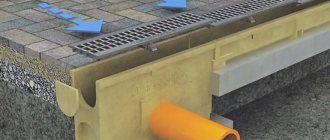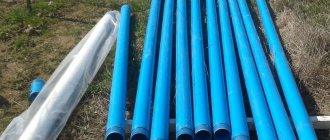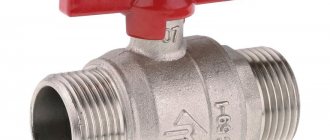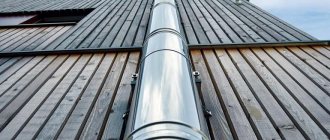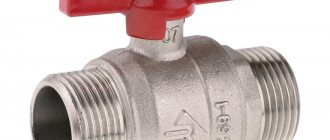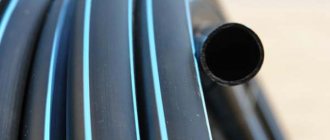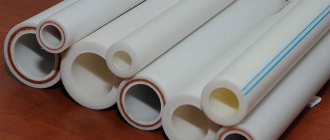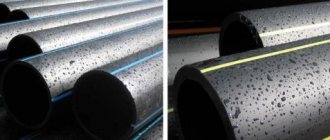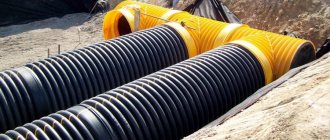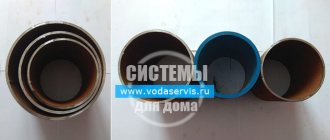Actually, what is the feasibility?
And look for expediency in the “bible” of electrical installation - a regulatory document called “Rules for the construction of electrical installations.” But we promised to explain the basic principles simply and clearly, so we deliver.
Even when there is no direct need regulated by the PUE, installation in protective pipes is justified in many situations. First of all, where it is necessary to create a physical barrier and distance the cable from the surface to the distance specified by the standards. Plus, this reduces the amount of oxygen available to the cable in the event of a fire.
Walls made of plastic or metal (correctly selected for specific operating conditions) can withstand external pressure and are resistant to aggressive substances such as acids and solvents.
It would be a good idea to provide protection for the cable from damage by rodents.
Additionally, the cable in the pipes is protected from possible exposure to moisture. You can’t do without a special reinforced corrugation (I’ll specify which one later) when making a concrete floor screed. Often this method of electrical installation greatly facilitates and speeds up the process of laying communications.
For example, it is more convenient to install several wires assembled in a bundle in one corrugation, plus the replacement of electrical wiring is ensured.
So, the decision was made to lay the wire in the pipe. Before I tell you which ones you need to choose, I’ll note which ones you don’t need to choose.
Features of electrical pipes made of polyvinyl chloride
PVC electrical pipes are produced using the continuous extrusion method. Such products are used for wiring electrical networks in buildings for various purposes: residential, industrial, as well as for underground installation of electrical cables. They reliably protect wires from mechanical influences, moisture, etc.
PVC channels can be laid underground
In modern buildings, it has become popular to openly locate the electrical pipeline. This allows, in the event of an unforeseen situation, to quickly diagnose and repair communications. PVC parts are also suitable for hidden installation in brick or concrete walls. Electrical wiring can be located on the floor, wall and ceiling. There are no categorical requirements for the working surfaces on which such a system will be installed. Installation can even be done on wooden material. They have good heat resistance (from – 20˚С to + 90˚С), so they can be used in unheated rooms and outdoors.
In addition, polyvinyl chloride burns quite poorly, so even if a short circuit occurs in the electrical network, a fire will not occur
This is a very important quality on which human life can depend. According to statistics, 40% of fires occur precisely due to a short circuit in the wiring
Smooth electrical PVC pipes are installed on flat areas of the room. The size of such products, as a rule, does not exceed 2 m. If necessary, you can independently divide the plastic product into the required sections. The joining of individual parts to each other occurs through special connecting elements, which are sold in the same place as the pipes.
Why water pipes are not suitable for cable
You may have repeatedly seen how cable laying (for example, to the distribution panel of a private cottage) is carried out in the ground using pipes for process water. So, this is far from the best solution.
Polyethylene pipes for process water are not advisable from the point of view of safety and economy
The truth is that water pipes, if they are without water, burn very quickly (when they are used as expected, with water, then, of course, they do not burn). Immediately a solid argument “against”. In principle, it is possible to lay cables in water pipes, but only if the entire structure is buried underground. In this case, there is no oxygen, which means there is no danger of combustion.
What about mechanical protection? There is also a big question here. Electrical cable pipes are designed to withstand external pressure in the form of compression. But water pipes maintain the pressure of water from the inside, so they are made to be resistant to pressure - this is a completely different specificity and, accordingly, design.
It should also be noted that this method is economically inappropriate. The fact is that the cost of pressure water pipes is higher than electrical installation ones.
In general, water pipes are not used for wiring because:
- they are more expensive
- they are flammable.
But if you have an extra ten meters of water supply, you can bury it with a cable to the nearest outbuilding on your summer cottage. But the electrical installation is still an order of magnitude better for laying in the ground, because it is strengthened precisely from the process of squeezing from the outside.
Don't need such a dubious compromise? Then you will have to choose from the originally intended options to lay the cable in the pipes.
Classification
These pipes are divided into groups:
- Nest is non-standard.
- C – average.
- SL – medium-light.
- T – heavy.
Smooth rigid pipes have excellent characteristics:
- strength,
- rigidity,
- durability,
- small price,
- they are resistant to corrosion,
- precipitation,
- temperature changes.
These pipelines have become widespread in the creation of various water supply systems, drainage systems and for laying cables and wires with open or hidden wiring.
Areas of application:
- technical wells;
- lay wires and cables;
- closed installation of telephone, electrical, computer and television communications;
- pipeline for drainage;
- sewer pipeline.
We choose with the help of an expert
To understand the nuances, I turned for detailed instructions to representatives of a large online electrical store in Ukraine - Axiom Plus, because We already know each other from previous jobs, and this specialized electrical engineering company has been engaged in the on-site supply of cables and installation systems since 2005 (including corrugated pipes - link to the section dedicated to them on the website).
I didn’t immediately persuade Evgeniy to have a consultation, and I didn’t have much time, but it was worth it. In addition to twelve years of experience in completing electrical equipment, he has the valuable ability to clearly and logically explain the essence of issues and concepts. This is what you will see after reading my article.
Related articles: Power cables in PVC insulation with aluminum core
Plastic or metal? - that is the question
The choice depends on what kind of wiring and under what conditions you plan to carry out. And it also requires relying on the standards prescribed in the PUE. But these are general words, so I’ll go straight to the specifics.
Metal pipes are practically not used in electrical installations
And this is the first thing you need to know. Pipes made of stainless or galvanized steel, aluminum, and brass are becoming less and less common on sale; they are becoming much less in demand and becoming a thing of the past. Mainly due to the inability to compete in cost with plastic analogues with approximately the same performance characteristics.
Where you cannot do without metal hoses is when installing electrical networks in fire hazardous areas: both indoors and outdoors (PUE, Chapter 7.4 “Electrical installations in fire hazardous areas”).
In a wooden building, a galvanized metal hose is required for electrical installation
The work is labor-intensive and financially expensive, but when organizing electrical wiring in a house made of wood, “the game is worth the candle” - or rather, your peace of mind is worth a lot.
That is, a metal hose is more than justified when installing cables in wooden houses, warehouses, and industrial premises where there is an increased risk of fire. But polyethylene, as a flammable material, is categorically not recommended. But it is recommended in most other situations.
Read more about the benefits of plastic pipes
Most often, PVC (polyvinyl chloride), polypropylene, HDPE and LDPE (low or high pressure polyethylene, respectively), polyamide (the highest level of stability and price) are used for their production. They are produced in two types - rigid and corrugated. Advantages of plastic systems:
- survivability (with proper operation up to 30-50 years),
- lightness of the design itself, as well as ease of installation,
- mechanical strength,
- corrosion resistance,
- wide range of sizes and mounting accessories.
To make it easier to understand where and which pipes are appropriate, we will distribute them by area of application.
Resistance to combustion is a mandatory quality for indoor electrical installations
Smooth PVC pipe
Basically, corrugated and smooth PVC (polyvinyl chloride) pipes are laid for wiring inside buildings. The main advantage of this material is that it does not support combustion. Including due to sealing using couplings during the installation process. Combustion is impossible where there is no oxygen supply.
However, PVC quickly deteriorates and cracks when exposed to sunlight, and therefore is not used for external installation work. What is used? See below.
External electrical wiring requires different solutions
Here you cannot do without pipes made of low-density polyethylene (HDPE) or polyamide. These are materials that are resistant to frost, moisture, aggressive substances and ultraviolet radiation. They protect the cable from damage during installation and perform the function of fire protection.
You will simplify the process of pulling the wire if you choose a pipe with a pulling probe included, which, by the way, does not significantly affect the price. And it saves a lot of time on electrical installation work.
Corrugated HDPE with a probe for pulling.
Visually suitable for external placement, pipes are produced in black, as they are minimally susceptible to the destructive effects of ultraviolet radiation.
What if you put it in the ground?
When laying in a trench, it is best to use polyethylene (again, HDPE), and double-walled (two-layer). Why double wall? The outer corrugation helps to achieve high strength and the ability to withstand high loads, and the inner smooth surface ensures quick and easy cable pulling along the entire length.
Related articles: Clinker tiles and laying rules
Double-walled protective red corrugation in a bay
Often pipes for laying in the ground are made in orange or red, which makes sense. The bright color catches the eye and makes it clear that the cable is laid in pipes here, no digging or drilling!
There are two types on sale: non-reinforced and reinforced (more durable, since steel wire is used in their construction). The latter are laid in areas with potentially high compressive loads. As for diameters, when installing in cottage and summer cottage areas, a diameter of 40-50 mm is often sufficient, and for industrial facilities up to 200 mm.
For convenience and clarity, I will collect recommendations in the form of a table
Recommended pipe materials depending on the method of electrical installation
Is it even possible without a pipe? It is possible (read the specific conditions in the PUE), especially if armored cables with high waterproofing characteristics are laid in trenches. BUT it is irrational: laying a simple cable in a protective pipe will cost less than special armored grades.
Types of polyethylene collectors
Plastic electrical collectors are made from two main types of polyethylene: LDPE (high pressure) and HDPE (low pressure). The difference between these materials is their density and thickness. LDPE products are quite durable, but are unstable to gases and are very sensitive to oxidative processes. HDPE pipe for electrical wiring, on the contrary, has good chemical resistance, but has low resistance to mechanical stress.
https://youtube.com/watch?v=YK6f4Imfh0E
Regardless of the type of polyethylene, PVC pipes for electrical wiring are classified into:
- hard,
- flexible.
What you need to know about sizes: diameters, inches and millimeters
First and foremost: the diameter is selected based on the type of cable to be laid. The most popular sizes in household electrical installations are from 16-20 mm to 50 mm. People who are inexperienced in electrical installations often get confused: what are the dimensions, in millimeters or inches?
It's actually simple. Electrical pipes are not measured in inches, but exclusively in millimeters. Inches are from the area of measuring water pipes and mounting elements for them. And we have already talked about the inappropriateness of their use for electrical installations. And now a few words about the diameter. It is logical that each pipe has walls of a certain thickness and, accordingly, two diameters, internal and external. Which one to take into account?
Perhaps a surprising answer: neither the first nor the second. As my interlocutor explained, you will have to focus on the nominal diameter. This means that the specified size satisfies the requirements of GOST, is suitable for laying the appropriate cable and can be easily combined with fasteners of the same conventional size. That is, the conventional 16 mm in fact may be 15.8 mm, but this diameter will work just as well.
In fact, it is not necessary to know exactly the internal and external diameters; use the conditional one as a guide. Dimensions up to a tenth of a millimeter will be needed in isolated cases - for example, the exact outer diameter, when you need to drill a hole with absolutely no gap. In the vast majority of cases, this information is not necessary.
cable in pipes manufactured by DKC
What is it for
The main purpose of the pipe in this case will be to protect against cable damage in the event of mechanical shocks, as well as to ensure fire safety if a wiring short circuit occurs.
The use of pipes as cable ducts is not a new invention. Some time ago, copper, aluminum or steel pipes were actively used for this purpose. But with the advent of plastic analogues, the demand for metal products in this situation has noticeably decreased.
Note that craftsmen advise using a PVC pipe for electrical wiring in both options for laying it - open or hidden.
Manufacturers and prices: is there a difference?
Here you must immediately understand that the main component of the cost is the amount of material spent on manufacturing. Plus transportation costs. The higher the quality of the plastic, and the more of it in the finished structure (the thicker and stronger the walls), the higher the price. Just like with cable, where the main pricing factor is the quantity and quality of copper.
And exactly the opposite: the lowest price will be for cheap plastic of dubious performance characteristics, which is also slightly under-produced.
Don't buy the cheapest noname!
As Evgeniy explained, the game of saving is not worth the candle. The difference in price between low-quality products from unknown manufacturers, with which the markets are flooded (especially a lot of penny corrugation), and factory-certified goods is insignificant.
So, you can buy a coil of normal pipe for installing internal electrical wiring for about 200 UAH. (focus on brands no less than the level of Kopos, DKC, IEK). And for something you don’t understand, you’ll pay 170-175 UAH at the market.
On volumes for the entire apartment, you will save 25 hryvnia - in absolute terms, a penny benefit is not worth the risks.
What exactly are the risks that come with a low price tag?
Firstly, no-name products without certificates and documents confirming their origin more than likely have defects that contradict the standards. Damage, ruptures, sagging, swelling, and delamination of the material are possible. As a result, a low degree of wear resistance and a high degree of fragility. The big question is the amount of plastic itself - perhaps they saved money on the thickness of the walls, and whether such corrugation is able to fulfill its function is unknown.
Related articles: Inverters and UPS in Moscow
Secondly, the quality of the plastic is unknown. How flammable/non-flammable is it really? I wouldn't want to test this in an extreme situation. What about toxicity? The nameless manufacturer does not provide information about the composition of cheap, non-certified material produced in artisanal conditions. How to make sure that its formula does not contain dangerous plasticizers - phthalates, or lead, formaldehyde, cadmium? And you and your loved ones will live and breathe here for decades.
Therefore, when making electrical installations in a house and laying cables in pipes, it is much more reasonable to lay them in pipes made of durable, non-flammable PVC that does not pose a risk of toxic fumes, which is confirmed by documents. And do this according to certain rules.
Installation Rules
To connect several wires and branch the network, an electrical box is used.
When laying a plastic pipeline for cable lines, the following rules must be observed:
- An unsealed route is made only for internal structures, as it provides exclusively mechanical protection.
- The distance of the duct from heating devices must be at least 10 cm. Moreover, it should be located lower to prevent heating.
- Connecting wires inside pipes is prohibited. This must be done in special mounting boxes.
- When the line is located in damp conditions, the joints are sealed with rubber gaskets and silicone.
- Fastening of products to the load-bearing surface should be done using metal clips.
- When placing pipes in grooves, before sealing them with mortar, they must be securely secured with staples.
- During installation, it is necessary to avoid the formation of creases, as this will complicate subsequent installation and maintenance of the line. When turning, you need to use elbows or corrugated inserts.
As for safety measures, you need to take into account that the traction rope is in a tense state; if handled carelessly, it can injure your hands.
A few rules for laying cables in pipes
It’s not enough to choose wisely. It is also necessary to carry out installation work in accordance with the rules. Namely, according to the fundamental document “Rules for the construction of electrical installations”. Among other things, it states that:
- When laying the cable in HDPE, it is necessary to fix the pipe with special brackets along the entire length of the structure at specified intervals. Depending on the situation and the object, the distance between the fixation points will be from 0.5 to 0.8 meters;
- when wiring is carried out in a hidden way, the size of the groove is calculated based on the diameter of the cable support systems, and not on the size of the conductor;
- When installing corrugations, avoid creating sharp corners.
Laying a conductor into metal sleeves has its own characteristics. Here, threaded couplings and elbows are used to connect the sections to each other. Often it is necessary to ground such a system.
Connecting elements for rigid PVC pipes
Strict regulation of production processes allows us to produce appropriate accessories for connecting PVC electrical pipes.
These parts are somewhat different from fittings for installing plumbing communications. Main connecting elements:
- corners - used to change the direction of laying communications;
- couplings – pipe-pipe connection, pipe-distribution box;
- tees - allow you to make wire taps.
- distribution and traction boxes are made with a transparent or regular lid;
- holders.
Angles and tees for rigid pipes can be with a solid body or collapsible (opening), connected with special latches. Manufacturers offer rigid and flexible connecting accessories. Couplings and solid corners provide a tight connection of communications. Tees and distribution boxes are similar dismountable devices that are used for installing communication wiring. For additional protection against moisture penetration, the accessories have rubber seals.
Electrical pipes are fastened using special plastic (or metal) snap holders, which differ little from snap-on clips for water pipes.
